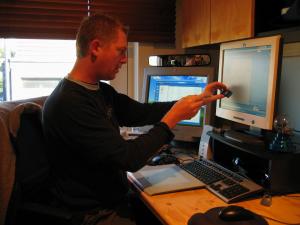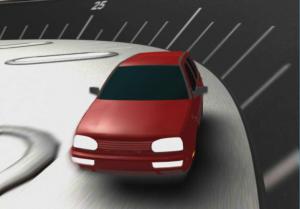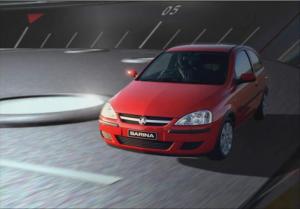Cars don’t tend to be small enough to race around the inside of watch faces, but Jonathan Dearing puts them there anyway. Dearing is a visual effects artist at Digital Pictures Sydney, and he recently road tested boujou bullet.
Dearing started his carreer as a camera operator and moved into visual effects. Dearing has worked in Singapore and around the world, and is currently focused on TVC large project work for Digital Pictures.
 Dearing’s primary tool for three dimensional camera tracking is boujou from 2d3, he has been using it since 2002. 2d3 started in 1999 and version 1.0 was only released in 2001. Dearing estimates he uses it on “just about every second job”. “It’s easy to use you can get going within a day, straight away really, but there are a few tricks you need to watch out for”.
Dearing’s primary tool for three dimensional camera tracking is boujou from 2d3, he has been using it since 2002. 2d3 started in 1999 and version 1.0 was only released in 2001. Dearing estimates he uses it on “just about every second job”. “It’s easy to use you can get going within a day, straight away really, but there are a few tricks you need to watch out for”.
For the Holden spots, the cars were shot on a wide open and flat car park. Chalked on the ground was a huge arc representing the curve of the watch and its bevel. Dearing’s challenge was to camera track from a swinging crane mounted on a moving camera truck – the motion blurred ground around the cornering high speed car. While the team placed markers on the ground, both for tracking and ‘correct’ reflections in the side of the car – matching the watch markings, the long shadows of the cars tended to run over the markers moving them from high sun to dark shadows. “It never tracks what you expect and other times it tracks things you’d never expect”, he jokes.
There were eight shots in total in the spot, and given the complexity each shot ended up taking about half a day to perfect, “it isn’t the tracking time thats the problem , it is the number of times you need to re do it , constantly adding markers and locators and matting out the moving car”. The cars were extremely complex as the tarmac had little visible texture, the colour was very uniform and most of the visual effects markers did not seem to stay in shot long enough. The wider shots were easy for this reason but every shot was successfully tracked and 3D matching watch faces built and animated.
 The final 3D was composited in Inferno HD, but using material and elements also produced in Shake by Digital Pictures lead Shake compositor Mick Harkin, “The shots went together really well, in comparison to some of the other car projects we’ve tackled in the past, these shots lined up incredibly easily”. Harkin and the team produced 1 x30 sec and 3 x 15 seconds spots to promote “time running out” for Sydney Advertising Agency Fame, and their client Holden. “Each 15 second spot featured a different car, and all but one car shot was a moving tracked shot- and that one I created completely from stills for an overhead wide shot” he comments.
The final 3D was composited in Inferno HD, but using material and elements also produced in Shake by Digital Pictures lead Shake compositor Mick Harkin, “The shots went together really well, in comparison to some of the other car projects we’ve tackled in the past, these shots lined up incredibly easily”. Harkin and the team produced 1 x30 sec and 3 x 15 seconds spots to promote “time running out” for Sydney Advertising Agency Fame, and their client Holden. “Each 15 second spot featured a different car, and all but one car shot was a moving tracked shot- and that one I created completely from stills for an overhead wide shot” he comments.
 Dearing used version 2 of boujou although Dearing has looked at the new boujou bullet and the prerelease details of version 3. Bullet offers version 2.0 functionality with a new user interface and ‘wizard’ option for a fraction of the full version pricing. Bullet retails for only US$2,500. “It seems to be everything I use – but with more windows, making it more friendly” he comments. The Bullet wizard explains not only the logical steps in solving a track but suggest such things as diamonds inside circles as the optimum tracking marker to use on set.
Dearing used version 2 of boujou although Dearing has looked at the new boujou bullet and the prerelease details of version 3. Bullet offers version 2.0 functionality with a new user interface and ‘wizard’ option for a fraction of the full version pricing. Bullet retails for only US$2,500. “It seems to be everything I use – but with more windows, making it more friendly” he comments. The Bullet wizard explains not only the logical steps in solving a track but suggest such things as diamonds inside circles as the optimum tracking marker to use on set.
 Ed Bolton, boujou technical specialist explains that ” since we released bullet after NAB, it has opened up the tracking market to medium and smaller facilities”, as well as allowing people outside a larger companies tracking department ,”do their own tracks and only when they get stuck – pass them to the dedicated tracking department”. To encourage Bullet’s adoption 2d3 allow demo version downloads from their web sites and immediate 5 day temp licences while they ship a dongle, but Bolton explains that they have stayed with the dongle solution so that different people, at different times in a facility can use the same copy. Bolton also points out that this system allows someone to download a copy, – experiment to see if they can get a solution and only then buy the software – “and immediately export a camera solution”, but be warned – having spent hours getting a track with the demo version- you can’t even save the file – so perhaps this suggestion is slightly optimistic ! boujou exports to any animation package with a 3D camerasuch as Max, maya, inferno or flame and exports 2D directly to Shake or as a text file, and works on Linux, PC and Mac OSX. We tested it on a 17″ powerbook – and it worked great, but screen space is a premium, so smaller laptops would be cramped.
Ed Bolton, boujou technical specialist explains that ” since we released bullet after NAB, it has opened up the tracking market to medium and smaller facilities”, as well as allowing people outside a larger companies tracking department ,”do their own tracks and only when they get stuck – pass them to the dedicated tracking department”. To encourage Bullet’s adoption 2d3 allow demo version downloads from their web sites and immediate 5 day temp licences while they ship a dongle, but Bolton explains that they have stayed with the dongle solution so that different people, at different times in a facility can use the same copy. Bolton also points out that this system allows someone to download a copy, – experiment to see if they can get a solution and only then buy the software – “and immediately export a camera solution”, but be warned – having spent hours getting a track with the demo version- you can’t even save the file – so perhaps this suggestion is slightly optimistic ! boujou exports to any animation package with a 3D camerasuch as Max, maya, inferno or flame and exports 2D directly to Shake or as a text file, and works on Linux, PC and Mac OSX. We tested it on a 17″ powerbook – and it worked great, but screen space is a premium, so smaller laptops would be cramped.
![]() Dearing’s approach to working with boujou is to first let boujou attempt to track on its own merit’s, “this does however usually require the adding of a mask over the moving hero”.
Dearing’s approach to working with boujou is to first let boujou attempt to track on its own merit’s, “this does however usually require the adding of a mask over the moving hero”.
If boujou does not come up with a smooth camera move on its own,” then it’s time to start adding either Target tracks, Locators or both”, he explains.
In his opinion, target tracks work best with matching circular patterns, so look for any patterns that may help. Locators help more if there is motion blur that is confusing boujou, “if you can consistently see a point even through the motion blur adding a locator to it makes it a gold track (a good track). If you can see a point you would like as a locator to help identify an area later, add a locator.”
If neither of these options results in a good track then Dearing suggests a combination of both.
 What is Dearing biggest complaint? “I do increasingly get asked by producers and clients to track objects, and this isn’t the point of boujou. boujou uses a moving camera to triangulate a camera position, you can invert the matte and then solve data for an object but only if the camera is moving”. Version three of boujou simplifies this process but “it is increasingly obvious that people want it to track objects” he explains. Another common request agrees technical specialist Ed Bolton is auto-masking options, “we have considered it”, he says, ” “We are considering it for version three”, he says. ” At the moment you can always import any black & white matte and use that or build your own”, from products such as Shake, Flame or Commotion.
What is Dearing biggest complaint? “I do increasingly get asked by producers and clients to track objects, and this isn’t the point of boujou. boujou uses a moving camera to triangulate a camera position, you can invert the matte and then solve data for an object but only if the camera is moving”. Version three of boujou simplifies this process but “it is increasingly obvious that people want it to track objects” he explains. Another common request agrees technical specialist Ed Bolton is auto-masking options, “we have considered it”, he says, ” “We are considering it for version three”, he says. ” At the moment you can always import any black & white matte and use that or build your own”, from products such as Shake, Flame or Commotion.
Version three of boujou is said to tackle one of the biggest problems in camera tracking: the use of zoom lenses. In boujou 2.0 zoom lens will normally fail to solve, “I am incredibly interested to see how version three tackles a zoom lens” Dearing comments. 2d3 will be showing boujou three at Siggraph and shipping it soon afterwards.
2d3 is based in Oxford and has about 20 staff, its parent company OMG also owns Vicon, which does motion capture systems. With such complementary technology bases it is often asked if 2d3 will explore realtime tracking. Bolton agrees” we have looked at it, actually we have a project called Lifeplus that is exploring this”. Lifeplus was started in 2002 as a joint venture for realtime, exploring augmented reality (AR) technologies, which is the processes of narrative design of fictional spaces (e.g.frescos) where users can experience a high degree of realistic interactive immersion. Based on a captured/real-time video of a real scene. This technology has obvious application to realtime previz and motion capture, but no details of the companies plans are yet released.
![]() Dearing expects to quickly move to version three when it is released. “Camera tracking is so much what we do now, we have years of experience and our clients have come to enjoy the freedom it gives them” he says , “I like the flexibility we can give our clients and how we always seem to find more and more innovate ways to solve things “.
Dearing expects to quickly move to version three when it is released. “Camera tracking is so much what we do now, we have years of experience and our clients have come to enjoy the freedom it gives them” he says , “I like the flexibility we can give our clients and how we always seem to find more and more innovate ways to solve things “.
Here is a link to a quicktime movie showing three stages of a shot from this project: Previz, camera footage, completed composite.
http://fxguide.com/modules/NewsUpload/uploads/bullet/previzA.mov
